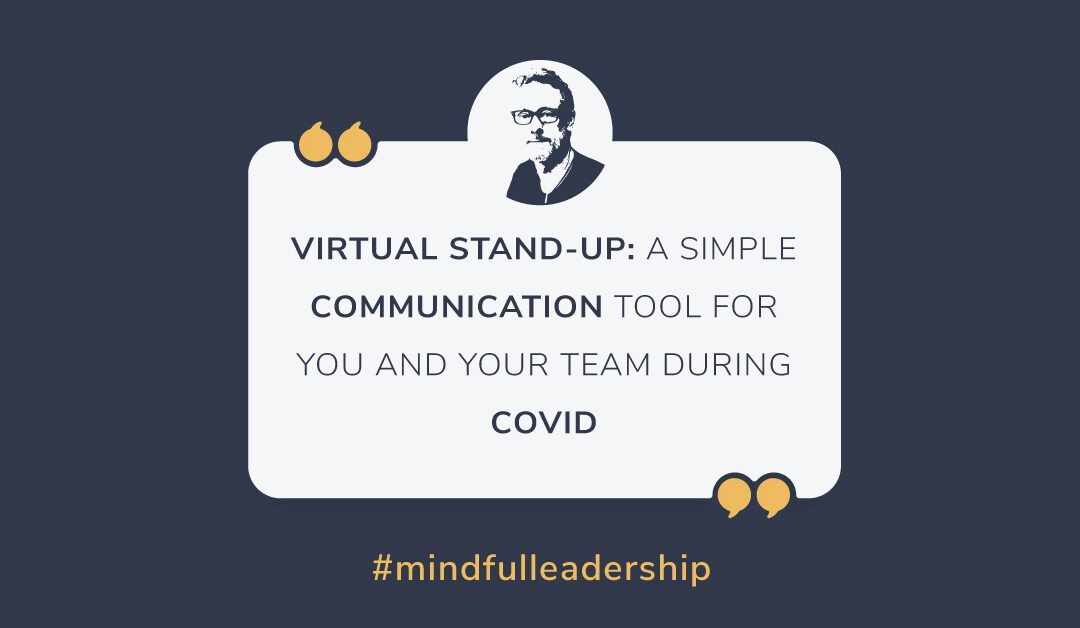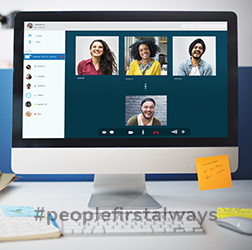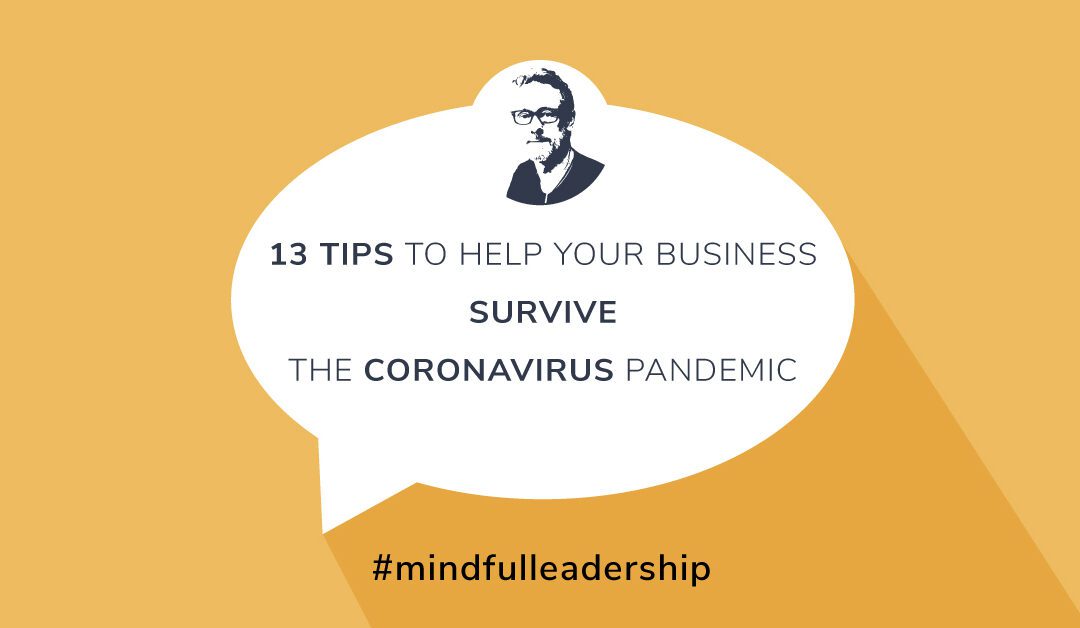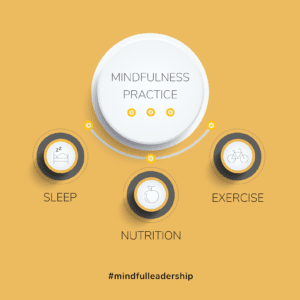
Virtual Stand-Up: A Simple Communication Tool for You and Your Team During COVID
Virtual Stand-Up: A Simple & Effective Communication Tool for You and Your Team During COVID-19
 By Grant Ian Gamble | April 17, 2020
By Grant Ian Gamble | April 17, 2020
Grant Ian Gamble is a business growth consultant, executive coach, author and keynote speaker. He works in a broad array of industries helping companies build teams, navigate change and drive growth.
 Monday through Friday every week, first thing in the morning, I facilitate a Virtual Stand Up with a management team I am consulting with. This helps the department heads stay connected, even though they’re not in the same physical work environment at the moment.
Monday through Friday every week, first thing in the morning, I facilitate a Virtual Stand Up with a management team I am consulting with. This helps the department heads stay connected, even though they’re not in the same physical work environment at the moment.
This daily Virtual Stand-Up reduces miscommunication, increases camaraderie, helps keep team members focused, and ultimately provides a community for people who are getting more and more disconnected as this pandemic expands its grip on our world.
Getting your team together for a daily Virtual Stand-Up can be fun, fulfilling and emotionally fortifying.
Daily virtual huddles might seem a bit much, but can be incredibly productive when you have the right guidelines in place.
Verne Harnish has championed a huddle concept he calls the “Daily Stand-Up”. The Stand-Up model covers three basic things:
What did you do yesterday?
What are you planning to do today?
Do you have any unique challenges you are currently facing?
The real beauty of this model is that each participant only has 60 seconds to download those three update items. This means that if you have 10 people on your team, the meeting should take no longer than 10 minutes.
From my experience, the most productive element of this format is declaring what we’re up to today. Some team members approach the day with plans in place, but most just wing it. This format asks those team members to be more proactive and less reactive.
Because of the nature of this format, it is very efficient. It needs a facilitator to manage people’s time and keep things on track, but from my experience, after a few meetings team members pick up the protocol really well and find it incredibly valuable.
» Here are some simple tips to ensure a successful Virtual Stand-Up:
- VIDEO CONFERENCE
- 60 SECONDS PER PERSON:
What did you do yesterday?
What are you planning to do today?
Do you have any unique challenges you are currently facing?
1. RELEVANT TOPICS
Ensure the topics team members present are relevant to the group. If they need to inform another team member of something, or have a discussion with them one-on-one, this is not the forum. Instead, encourage them to have the conversation independently.
2. HIGHLIGHTS ONLY
When team members review what they did yesterday, they need to focus on highlights only. The same applies to their plans for today. NOTE: When reviewing yesterday on a Monday, we refer back to Friday’s events.
3. SHARING UNIQUE CHALLENGES
When reviewing any unique challenges they are facing, these should be things that are impeding progress or causing them undue angst. This does not include things that apply to everyone like the weather, or this pandemic. An example would be, “My internet is down at home.” This is good for others to know and obviously is a relevant issue given the current lockdowns.
4. USE A TIMER
Initially, use a timer. This won’t be necessary for the long term, but people will initially give more detail than needed and when the buzzer goes off it is a good reminder to keep it short.
5. ENCOURAGE OFFLINE CONVERSATIONS
If a team member goes off on a tangent or a conversation starts up between two people, the facilitator needs to interject and suggest they take the conversation offline after the call. They can even stay on the call after everyone else drops off, or schedule a separate call or meeting.
6. ALWAYS START ON TIME
Always start the meeting on time. Team members will learn that this is a short, sharp and functional opportunity to stay connected and dialing in on time is expected.
7. USE A RELIABLE VIDEO CONFERENCING TOOL
Use a reliable conferencing tool. I usually use Google Hangouts and put the meeting on repeat so that people have it on their calendar and can dial in easily. There are lots of free conferencing tools out there, so take your pick.
8. REDUCE BACKGROUND NOISE
Encourage team members to mute their devices when they’re not talking in order to reduce background noise.
9. VIDEO, VIDEO, VIDEO!
As often as possible, I suggest doing a video call instead of a phone call. Some teams do a video call every time. This leaves less room for distractions and miscommunication as it’s much easier for people to read each other’s emotions when they can see each other.
If you limit each team member to 60 seconds and stick to this routine, you’ll quickly experience the benefits. These meetings can be critical in keeping your team on track and maintaining your work community.
I have used this format in many scenarios, but never quite as beneficially as today.
We need each other more than ever, and having simple and productive rituals like Virtual Stand Ups will help your team stay aligned, productive and connected.
Other Articles to Help You Through Uncertain Times:
-
Strategies to Follow as You Re-Open or Re-Imagine Your Business in the New COVID-19 Reality
-
How to Transcend Troubling Times
-
4 Tips to Proactively Address the Stress of COVID-19
-
5 Steps to Re-Imagine Your Business Post COVID-19
-
Change Management During Uncertain Times
-
26 Non-Negotiables, Opportunities & Tips for Surviving and Thriving During and After the COVID-19 Pandemic
-
30 Business Sectors That Are Booming During the COVID-19 Pandemic
-
Overcoming F.E.A.R. During COVID Uncertainty
-
Virtual Training During and Beyond COVID-19
-
13 Tips to Help Your Business Survive the Coronavirus Pandemic
Fill out the form below and receive a PDF download of "6 Key Strategies to Engage Untapped Fitness and Wellness Market Segments"
Let's Connect!
CUSTOMER EXPERIENCE, TEAM ENGAGEMENT & WORKPLACE WELL-BEING: AFFINITY OS™ | WELLNESS INTEGRATION | MINDFUL LEADERSHIP: "THE AFFINITY PRINCIPLE"
0475 866 592

The Affinity Principle™ by Grant Gamble presents a formula for business success through a people-centric, mindful leadership approach.
PEOPLE FIRST, ALWAYS.



 Business is in turmoil across the globe as we attempt to navigate this new world order.
Business is in turmoil across the globe as we attempt to navigate this new world order.


 Being a Mindful Leader is not about having a yoga or meditation practice. Truly mindful leaders imbibe intentionality, awareness and an abiding presence. Exhibiting these characteristics, consistently, is incredibly hard amidst the cacophony of competing interests for your time and focus.
Being a Mindful Leader is not about having a yoga or meditation practice. Truly mindful leaders imbibe intentionality, awareness and an abiding presence. Exhibiting these characteristics, consistently, is incredibly hard amidst the cacophony of competing interests for your time and focus. Sleep
Sleep Good Nutrition
Good Nutrition

 Find a time, first thing in the morning, or after the kids have gone to bed, or even on your lunch break, where you can take just a few minutes to shift your focus inward. You can build on those smaller increments of time and ideally increase your practice to ten, fifteen, or more minutes daily as your mindful muscle builds.
Find a time, first thing in the morning, or after the kids have gone to bed, or even on your lunch break, where you can take just a few minutes to shift your focus inward. You can build on those smaller increments of time and ideally increase your practice to ten, fifteen, or more minutes daily as your mindful muscle builds.







 Another example of getting participants present in meetings comes from Verne Harnish. I had been introduced to the concept of a stand-up meeting in a talk I attended about the Ritz Carlton’s famous service model. Verne further refined this concept for me with a three-step process, and I used it to great effect in a beleaguered organization I was asked to come and work with and reform:
Another example of getting participants present in meetings comes from Verne Harnish. I had been introduced to the concept of a stand-up meeting in a talk I attended about the Ritz Carlton’s famous service model. Verne further refined this concept for me with a three-step process, and I used it to great effect in a beleaguered organization I was asked to come and work with and reform: When we started, these managers were none too happy to be meeting on a daily basis, recounting their woes and what they planned to do about them. There was nowhere to hide, and as the posturing and objections subsided these meetings began to make them focus their thinking on what was really going on in their department and what they were doing about it.
When we started, these managers were none too happy to be meeting on a daily basis, recounting their woes and what they planned to do about them. There was nowhere to hide, and as the posturing and objections subsided these meetings began to make them focus their thinking on what was really going on in their department and what they were doing about it.